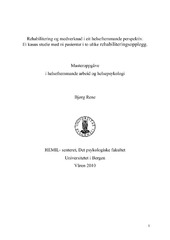| dc.contributor.author | Rene, Bjørg | |
| dc.date.accessioned | 2012-01-19T09:48:11Z | |
| dc.date.available | 2012-01-19T09:48:11Z | |
| dc.date.issued | 2010-06-04 | eng |
| dc.identifier.uri | https://hdl.handle.net/1956/5472 | |
| dc.description.abstract | Purpose: To measure the status and change of performance of Activities of daily living (ADL) in stroke patients receiving home-based rehabilitation (HR) compared to patients receiving hospital-based rehabilitation (Usual R), and to explore the patients’ experiences of participation collaboration with the rehabilitation professionals. Method. Case-study with nine patients (HR=5, UR=4). The patients’ level of independence in ADL was assessed by using Assessment of Motor and Process Skills acute, 3 and 6 months after the stroke, analyzed through t-test for independent groups, and paired t-test for changes within groups. A semi-structured interview were accomplished after 6 months, and analyzed by meaning- and text-condensation. The results were triangulated in the discussion of the results. Results. There were no difference between the groups measured by AMPS, nor were any differences found regarding participation and collaboration. Best progress in ADL motor skills were found from baseline to 3 months for the younger. Cross-wise only two participated and collaborated considerable with the rehabilitation professionals. The common aspects for these two seems to be their personal resources related to participation and collaboration, shown through their ability to express own needs, set realistic and meaningful goals, and their ability to have a dialogue with the professionals related to their health care needs. The rest of the patients experienced varying or little opportunity for participation and collaboration during the rehabilitation process. Conclusion. The present results gave no conclusive results regarding differences between groups on either question. Nevertheless the study showed rehabilitation as a long lasting process for the patients. Participation and collaboration seems to be tied to individual personal resources than being a systematic approach regarding an empowering aspect in rehabilitation. Both HR and UR seems to be directed by a curative understanding of rehabilitation with the aim of bettering skills in ADL, rather than accomplishing a holistic and empowering rehabilitation process as stated in health policy documents from the authorities. | en_US |
| dc.description.abstract | Formål: Denne studien handlar om rehabilitering av pasientar med hjerneslag. Målet var å undersøke pasientane sine erfaringar med to ulike rehabiliteringsopplegg, eit heimebasert (HR) versus eit vanlig rehabiliteringsforløp (VR). Dette for å få fram kunnskap om eventuell skilnad i status og endring i ADL ferdigheitar over tid, samt pasientane si eigen opplevde medverknad i dei respektive rehabiliteringsopplegga. Metode: Studien vart gjennomført som ei kasus studie med ni pasientar (5 i HR- og 4 i VRgruppa). AMPS (Assessment of Motor and Process Skills) vart nytta som test ved oppstart, 3 og 6 månader etter slaget. Skilnad mellom gruppene vart analysert med t-test for uavhengige grupper, og med para t-test for endring innad i gruppene. Opplevd medverknad vart innhenta gjennom intervju 6 månader etter slaget, og analysert ved hjelp av tekst- og meiningsfortetting. Data vart kopla i drøfting av resultata. Funn: Ingen signifikant skilnad mellom HR og VR vart funne i verken ADL eller i medverknad. På tvers av gruppene kom det fram at dei yngste hadde best framgang i ADL motoriske ferdigheitar fyrste 3 månadane, og to pasientar medverka betydeleg gjennom heile forløpet. Fellesnemnaren for desse to synes å vera personlege ressursar i høve til medverknad. Dei gav uttrykk for eigne behov, var i dialog om tiltak, sette realistiske mål for seg sjølv og kravde oppfylging over tid. Dei andre hadde varierande og til dels liten grad av medverknad. Konklusjon: Det var ikkje muleg å trekkja konklusjonar om skilnad mellom gruppene i dette utvalet. Studien viser imidlertid at rehabilitering var ein langvarig prosess for pasientane. Det synest som at medverknad her kan knytast meir til individet sine ressursar, enn til ei systematisk tilrettelegging for medverknad. Både HR og VR synes å vera styrt meir av ei kurativ oppfatning av rehabilitering med individet si funksjonsbetring som mål, og mindre av eit heilskapleg og myndiggjerande perspektiv slik offentlege dokument og føringar legg opp til. | en_US |
| dc.language.iso | nno | eng |
| dc.publisher | The University of Bergen | eng |
| dc.subject | Homebased rehabilitation | eng |
| dc.subject | Hospitalbased rehabilitation | eng |
| dc.subject | Health promotion | eng |
| dc.subject | Participation | eng |
| dc.subject | Collaboration | eng |
| dc.subject | Empowerment | eng |
| dc.title | Rehabilitering og medverknad i eit helsefremmande perspektiv. Ei kasus studie med ni pasientar i to ulike rehabiliteringsopplegg. | eng |
| dc.type | Master thesis | |
| dc.rights.holder | Copyright the author. All rights reserved | |
| dc.description.degree | Master i Helsefremmende arbeid og helsepsykologi | |
| dc.description.localcode | HEFR395 | |
| dc.description.localcode | MAPS-HEFR | |
| dc.subject.nus | 761901 | eng |
| dc.subject.nsi | VDP::Medical disciplines: 700::Health sciences: 800 | eng |
| fs.subjectcode | HEFR395 | |
